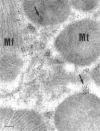Mitochondrial extracellular vesicles, autoimmunity and myocarditis
- PMID: 38550582
- PMCID: PMC10972887
- DOI: 10.3389/fimmu.2024.1374796
Mitochondrial extracellular vesicles, autoimmunity and myocarditis
Abstract
For many decades viral infections have been suspected as 'triggers' of autoimmune disease, but mechanisms for how this could occur have been difficult to establish. Recent studies have shown that viral infections that are commonly associated with viral myocarditis and other autoimmune diseases such as coxsackievirus B3 (CVB3) and SARS-CoV-2 target mitochondria and are released from cells in mitochondrial vesicles that are able to activate the innate immune response. Studies have shown that Toll-like receptor (TLR)4 and the inflammasome pathway are activated by mitochondrial components. Autoreactivity against cardiac myosin and heart-specific immune responses that occur after infection with viruses where the heart is not the primary site of infection (e.g., CVB3, SARS-CoV-2) may occur because the heart has the highest density of mitochondria in the body. Evidence exists for autoantibodies against mitochondrial antigens in patients with myocarditis and dilated cardiomyopathy. Defects in tolerance mechanisms like autoimmune regulator gene (AIRE) may further increase the likelihood of autoreactivity against mitochondrial antigens leading to autoimmune disease. The focus of this review is to summarize current literature regarding the role of viral infection in the production of extracellular vesicles containing mitochondria and virus and the development of myocarditis.
Keywords: AIRE; autoimmune disease; coxsackievirus; extracellular vesicles; mitochondria; mitochondrial-derived vesicles; myocarditis.
Copyright © 2024 Di Florio, Beetler, McCabe, Sin, Ikezu and Fairweather.
Conflict of interest statement
The authors declare that the research was conducted in the absence of any commercial or financial relationships that could be construed as a potential conflict of interest. The author(s) declared that they were an editorial board member of Frontiers, at the time of submission. This had no impact on the peer review process and the final decision.
Figures




References
-
- Fairweather D, Root-Bernstein R. Autoimmune disease: Mechanism. In: Encyclopedia of life sciences. John Wiley & Sons, Ltd, Chichester, UK: (2015). p. 1–7. doi: 10.1002/9780470015902.a0020193.pub2 - DOI
Publication types
MeSH terms
Grants and funding
LinkOut - more resources
Full Text Sources
Medical
Miscellaneous

